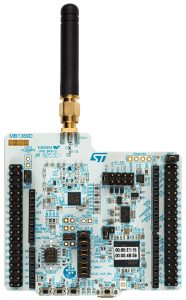A partnership with Kinéis, an Authorized ST Partner and a satellite operator, means that the STM32WL can now send messages into space, offering developers global coverage. Furthermore, Kinéis launched SmartSat, the first step of their VAM program, to accelerate new product development. It takes users on a step-by-step journey showing how they can try the Kinéis network on a NUCLEO-WL55JC thanks to pre-compiled binaries in a full STM32CubeIDE project. Consequently, satellite connectivity on a general-purpose microcontroller for an IoT application has never been simpler. ST and Kinéis held a webinar in 2023 to help users get started.
Challenges of satellite communication for IoT
The idea of using satellite communication to connect IoT devices has recently been gaining traction. In 2021, an article published in IEEE Spectrum1 by Michael Koziol explores the use of such networks for IoT applications where terrestrial alternatives are inexistent. Thanks to sub-GHz RF that can reach low Earth orbit satellites, it’s increasingly easier to send small packets to space. Often, satellite communication is a fallback when using a traditional LoRa, 5G, or other terrestrial networks. As long as a system doesn’t require a constant flux of time-sensitive information, satellite communication does provide vastly superior coverage.
However, numerous issues still prevent satellite-aided IoT applications from becoming mainstream. The barrier to entry is often high when networks demand dedicated devices. The technologies also remain expensive, especially those that use CubeSat, a miniature satellite of 10 cm<sup>3</sup>. Because those satellites only last a year or two in space and have limited coverage due to their low orbit (around 500 km or 300 miles), network operators must keep a large fleet to provide a robust service. However, that contributes to higher costs and space debris. Moreover, recent Cubesats suffered from reliability issues, with half of those brought up by Artemis 1 malfunctioning, according to SpaceNews.
The Kinéis solution
Kinéis sidesteps all those issues by using different nanosatellites at a higher orbit (650 km or 400 miles). Consequently, the Kinéis constellation is still reachable with off-the-shelf devices like the STM32WL, each satellite covering significantly more ground (5000 kilometers or more than 3100 miles). As a result, the network needs fewer satellites (a few dozen versus a few hundred for competing solutions), and IoT devices can communicate with them longer. Kinéis satellites also last eight years in space and have a reentry sequence, so they don’t add to the space trash issue once inactive.
Kinéis already has nine satellites supporting the STM32WL thanks to its 22 dBm of output power, and it will be sending 25 more this year over the course of five launches. Engineers can thus start experimenting and jump on the bandwagon early. It’s why ST and Kinéis organized a webinar last February and are preparing another one for April 18. It also explains why both companies work to bring the solution to the STM32WL. Kinéis’ stack is already available and will provide an abstraction layer to help developers quickly send messages to space. Moreover, the RF drivers take care of the radio modulation using the included RF transceiver in the STM32WL and includes a frame builder to share payloads.

For those wishing to experiment with the Kinéis constellation, the NUCLEO-WL55JC provides the quickest path to a trial. Kinéis also recommends using the ANT-410-CW-QW-SMA antenna by Linx Technologies with the Nucleo board. However, the VAM program is interesting because it is the first time that an off-the-shelf LoRa development platform selling for less than USD50 can become a testing ground for satellite-aided IoT, thus vastly lowering the barrier to entry. Companies choosing the Kinéis constellation will also appreciate how the Nucleo board serves as a stepping stone for their STM32WL system.
- Satellites Can Be a Surprisingly Great Option for IoT. Michael Koziol. IEEE Spectrum. August 12, 2021. ↩︎




